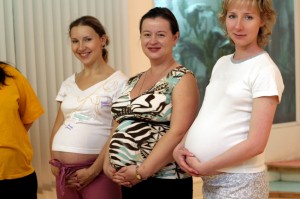 The health of pregnant women can say a lot about a region. It can indicate the accessibility and affordability of health care, as well as how much recognition maternal health receives in the region. A healthy pregnancy results in healthier children and decreased risk for maternal death. Conversely, measuring maternal mortality rates can also indicate the level of health resources within a country
The health of pregnant women can say a lot about a region. It can indicate the accessibility and affordability of health care, as well as how much recognition maternal health receives in the region. A healthy pregnancy results in healthier children and decreased risk for maternal death. Conversely, measuring maternal mortality rates can also indicate the level of health resources within a country
In 2000, the United Nations adopted the Millennium Declaration, which established a series of goals including Millennium Development Goal 5. The goal aimed for a 75% reduction in the maternal mortality ratio (MMR) from 1990 to 2015. The MMR is a common statistic used to indicate the number of women, that die while pregnant or within 42 days of giving birth, for every 100,000 live births.
The Bill and Melinda Gates Foundation funded a study looking at maternal mortality rates over the past 28 years. In a report published in the Lancet this May, the authors examined the MMR across the globe using a variety of national and regional reports.
Using this data, the authors determined that there were about 340,000 maternal deaths in 2008 compared with 530,000 deaths in 1980. Between 1980 and 2008, the authors found some interesting trends. India had the largest number of maternal deaths of any country overall but the MMR substantially decreased over time. Eastern Asia reported the greatest reduction in maternal deaths while maternal mortality actually increased in sub-Saharan Africa during the 1990s. As of 2008, sub-Saharan Africa made up 52% of the global maternal deaths.
Additionally, in 2008, all the countries in western Europe, Canada, and Australia had maternal mortality rates below 10 (Italy was lowest with 4). The USA, on the other hand, had an MMR of 17, an increase from 1980, which the authors say may be due to increased reporting.
In contrast, over 21 countries had no data for the entire period between 1980 and 2008. Many of these countries are in northern Africa and the Middle East, which may indicate a low awareness of maternal mortality issues.
While the global MMR decreased over the past 28 years, the spread of HIV over the 1980s and 1990s initially caused maternal deaths to increase. Better treatment of HIV-positive women now prevents many of these maternal deaths (and decreases the spread of the virus during childbirth). Over this time period, the MMR was estimated to decrease 1.5% a year. While an improvement, it does not meet the 5.5% annual MMR decrease needed to meet Millennium Development Goal 5.
While the authors could only speculate on the direct causes of decreased maternal death rates, they do suggest some possibilities. During this same time period as the study, the total fertility rate decreased, which usually correlates with decreases in maternal mortality. In addition, income per person rose, particularly in Asia and Latin America. This can affect maternal and child mortality by increasing nutritional status and access to health care. Maternal education levels and birth assistance by a skilled professional also increase maternal health.
While it appears that the maternal mortality ratio will not meet the 2015 goals of the Millennium Declaration, continued efforts are being put forth to promote this important issue. President Obama has also proposed the Global Health Initiative, which will invest federal dollars to help other countries strengthen their health systems, with an emphasis on maternal and child health. In addition, public health advocacy groups also work around the globe to support this mission, including the White Ribbon Alliance. By working together, these organizations may continue to increase the awareness of health care for pregnant women and reduce maternal deaths.
______________
To read Kate’s posts about issues surrounding cancer and fertility, go to the Oncofertility Consortium Blog.
 In a bold announcement today, Apple and Facebook now will offer health coverage for their women employees to freeze their eggs. Egg freezing may enable women to protect and preserve their fertility—and with the steep price of $10,000+, this coverage may be seen as a significant investment in family planning, while others may see this as concerning. Climbing the corporate ladder while raising a family can be a significant barrier for many women and the health coverage to freeze one’s eggs can provide women with the choice and freedom to devote time to work and to one’s family. However, some argue this potentially pushing women to focus on their careers as primary and family as secondary.
In a bold announcement today, Apple and Facebook now will offer health coverage for their women employees to freeze their eggs. Egg freezing may enable women to protect and preserve their fertility—and with the steep price of $10,000+, this coverage may be seen as a significant investment in family planning, while others may see this as concerning. Climbing the corporate ladder while raising a family can be a significant barrier for many women and the health coverage to freeze one’s eggs can provide women with the choice and freedom to devote time to work and to one’s family. However, some argue this potentially pushing women to focus on their careers as primary and family as secondary.
 Oncofertility is an interdisciplinary field at the intersection of oncology and reproductive medicine that expands fertility options for young cancer survivors. Experts in this field identify which cancer treatments are likely to damage later reproductive ability for men, women, and children and develop new fertility preservation methods. In addition, these scientists are also identifying cancer treatments that may be “fertoprotective” and prevent damage to the reproductive organs during cancer treatment. Every year, experts in this field meet to discuss the recent advances in oncofertility scientific and medical treatment. The sixth annual
Oncofertility is an interdisciplinary field at the intersection of oncology and reproductive medicine that expands fertility options for young cancer survivors. Experts in this field identify which cancer treatments are likely to damage later reproductive ability for men, women, and children and develop new fertility preservation methods. In addition, these scientists are also identifying cancer treatments that may be “fertoprotective” and prevent damage to the reproductive organs during cancer treatment. Every year, experts in this field meet to discuss the recent advances in oncofertility scientific and medical treatment. The sixth annual  This weekend, the
This weekend, the  Dr. Teresa Woodruff, Director of the Institute for Women's Health Research at Northwestern, and her colleagues have just released their second book on oncofertility. Oncofertility is a new field of study named by Dr. Woodruff who is a leader in the study of fertility preservation in women who have lost their fertility due to cancer therapies and other conditions that threaten their ability to conceive and bear children. The issue of fertility preservation is of particular concern to young breast cancer survivors and their health care team. To learn more about this book and where to find it read below.
Dr. Teresa Woodruff, Director of the Institute for Women's Health Research at Northwestern, and her colleagues have just released their second book on oncofertility. Oncofertility is a new field of study named by Dr. Woodruff who is a leader in the study of fertility preservation in women who have lost their fertility due to cancer therapies and other conditions that threaten their ability to conceive and bear children. The issue of fertility preservation is of particular concern to young breast cancer survivors and their health care team. To learn more about this book and where to find it read below. A study by researchers at the National Institutes of Health (NIH) and the University of Oxford supports the widespread belief that stress may reduce a woman's chance of becoming pregnant. The study is the first of its kind to document, among women without a history of fertility problems, an association between high levels of a substance that is indicative of stress and a reduced chance of becoming pregnant.
A study by researchers at the National Institutes of Health (NIH) and the University of Oxford supports the widespread belief that stress may reduce a woman's chance of becoming pregnant. The study is the first of its kind to document, among women without a history of fertility problems, an association between high levels of a substance that is indicative of stress and a reduced chance of becoming pregnant. No, you did not open the wrong page. Yes, this blog is posted by the
No, you did not open the wrong page. Yes, this blog is posted by the  Low testosterone levels to blame for low libido, fatigue and weight gain
Low testosterone levels to blame for low libido, fatigue and weight gain The health of pregnant women can say a lot about a region. It can indicate the accessibility and affordability of health care, as well as how much recognition maternal health receives in the region. A healthy pregnancy results in healthier children and decreased risk for maternal death. Conversely, measuring maternal mortality rates can also indicate the level of health resources within a country
The health of pregnant women can say a lot about a region. It can indicate the accessibility and affordability of health care, as well as how much recognition maternal health receives in the region. A healthy pregnancy results in healthier children and decreased risk for maternal death. Conversely, measuring maternal mortality rates can also indicate the level of health resources within a country Vaginal birth after cesarean (VBAC) is the delivery of a baby through the vagina after a previous cesarean delivery. For most of the 20th century, clinicians believed that once a woman had undergone a cesarean, all of her future pregnancies required delivery by that procedure as well. In the 1980s, vaginal birth after cesarean (VBAC) also began to be considered a viable option for these women. Since 1996, however, VBAC rates in the United States have consistently declined, while cesarean delivery rates have been steadily rising. What accounts for these changing practice patterns? An improved understanding of the clinical risks and benefits of both procedures, and how these risks interact with legal, ethical, and economic forces to shape provider and patient choices about VBAC, may have important implications for health services planning and informed decisionmaking.
Vaginal birth after cesarean (VBAC) is the delivery of a baby through the vagina after a previous cesarean delivery. For most of the 20th century, clinicians believed that once a woman had undergone a cesarean, all of her future pregnancies required delivery by that procedure as well. In the 1980s, vaginal birth after cesarean (VBAC) also began to be considered a viable option for these women. Since 1996, however, VBAC rates in the United States have consistently declined, while cesarean delivery rates have been steadily rising. What accounts for these changing practice patterns? An improved understanding of the clinical risks and benefits of both procedures, and how these risks interact with legal, ethical, and economic forces to shape provider and patient choices about VBAC, may have important implications for health services planning and informed decisionmaking.